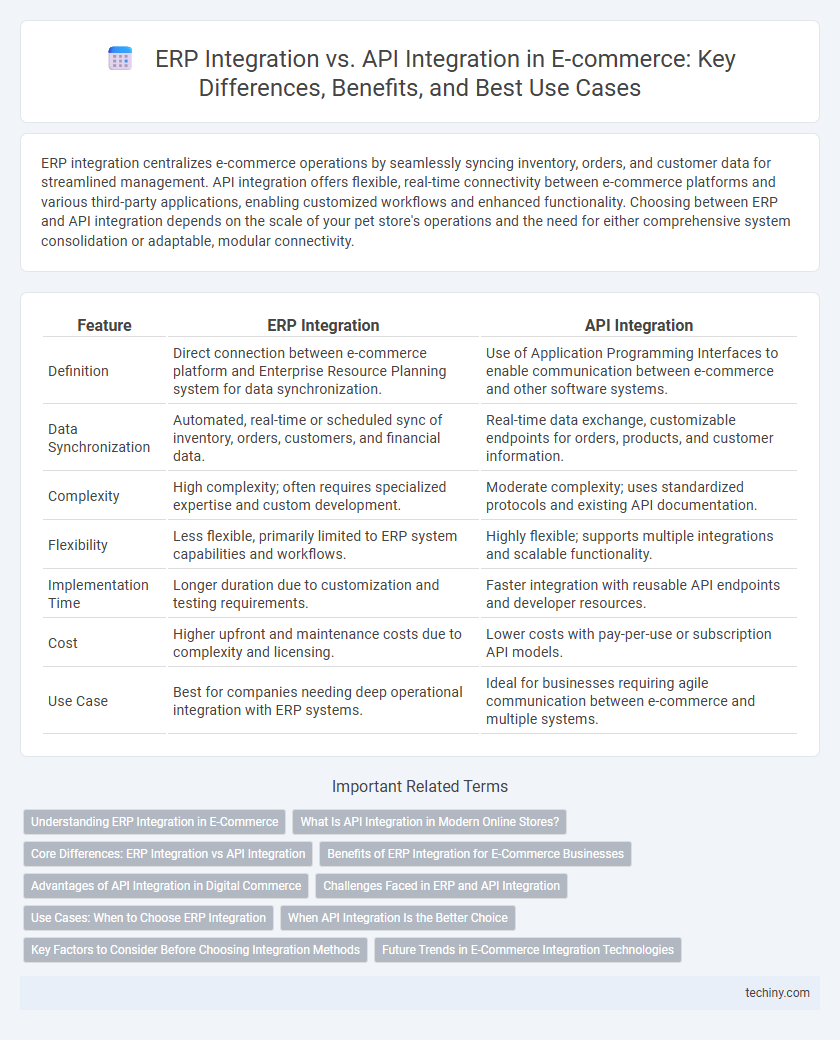ERP integration centralizes e-commerce operations by seamlessly syncing inventory, orders, and customer data for streamlined management. API integration offers flexible, real-time connectivity between e-commerce platforms and various third-party applications, enabling customized workflows and enhanced functionality. Choosing between ERP and API integration depends on the scale of your pet store's operations and the need for either comprehensive system consolidation or adaptable, modular connectivity.
Table of Comparison
| Feature | ERP Integration | API Integration |
|---|---|---|
| Definition | Direct connection between e-commerce platform and Enterprise Resource Planning system for data synchronization. | Use of Application Programming Interfaces to enable communication between e-commerce and other software systems. |
| Data Synchronization | Automated, real-time or scheduled sync of inventory, orders, customers, and financial data. | Real-time data exchange, customizable endpoints for orders, products, and customer information. |
| Complexity | High complexity; often requires specialized expertise and custom development. | Moderate complexity; uses standardized protocols and existing API documentation. |
| Flexibility | Less flexible, primarily limited to ERP system capabilities and workflows. | Highly flexible; supports multiple integrations and scalable functionality. |
| Implementation Time | Longer duration due to customization and testing requirements. | Faster integration with reusable API endpoints and developer resources. |
| Cost | Higher upfront and maintenance costs due to complexity and licensing. | Lower costs with pay-per-use or subscription API models. |
| Use Case | Best for companies needing deep operational integration with ERP systems. | Ideal for businesses requiring agile communication between e-commerce and multiple systems. |
Understanding ERP Integration in E-Commerce
ERP integration in e-commerce streamlines operations by synchronizing inventory, orders, and customer data between the online store and the enterprise resource planning system. This integration reduces manual data entry errors, ensures real-time updates, and improves overall efficiency in supply chain management. Compared to API integration, ERP integration often involves deeper system-level connectivity tailored to specific business processes and resource planning needs.
What Is API Integration in Modern Online Stores?
API integration in modern online stores enables seamless communication between e-commerce platforms and third-party applications, optimizing inventory management, payment processing, and customer data synchronization. By automating data exchange through standardized protocols, API integration reduces manual errors and enhances real-time operational efficiency. This approach supports scalable functionality, allowing online retailers to quickly adapt to market trends and integrate diverse services such as marketing tools, shipping providers, and analytics dashboards.
Core Differences: ERP Integration vs API Integration
ERP integration involves embedding e-commerce platforms directly into enterprise resource planning systems for unified data management and automated workflows, enhancing inventory, order processing, and financial reporting within a single system. API integration relies on application programming interfaces to enable communication between e-commerce software and external systems, offering flexible, modular connectivity and real-time data exchange without deeply altering the core ERP architecture. The core difference lies in ERP integration's monolithic approach for comprehensive system unification versus API integration's modular, scalable method focused on interoperability and agility.
Benefits of ERP Integration for E-Commerce Businesses
ERP integration streamlines operations by consolidating inventory management, order processing, and customer data into a unified system, enhancing efficiency and reducing errors. It provides real-time visibility into supply chain activities, enabling faster decision-making and improved demand forecasting. Seamless ERP integration supports scalability for e-commerce businesses, facilitating smoother expansion and better resource allocation.
Advantages of API Integration in Digital Commerce
API integration in digital commerce enables seamless real-time data synchronization between e-commerce platforms and third-party services, enhancing inventory management accuracy and order processing speed. Unlike traditional ERP integration, APIs offer greater flexibility and scalability, allowing businesses to quickly adapt to market changes and integrate with a wide range of applications such as payment gateways, CRM, and analytics tools. The use of APIs reduces manual data entry errors and streamlines workflows, ultimately improving customer experience and operational efficiency.
Challenges Faced in ERP and API Integration
ERP integration faces challenges such as data synchronization errors, scalability issues, and high implementation costs due to complex legacy systems. API integration encounters difficulties including inconsistent data formats, limited API documentation, and security vulnerabilities during data transmission. Both methods require robust testing and ongoing maintenance to ensure seamless e-commerce operations and accurate real-time data exchange.
Use Cases: When to Choose ERP Integration
ERP integration is ideal for e-commerce businesses that require a centralized system to manage inventory, accounting, and customer data across multiple departments, ensuring seamless workflow automation. Complex operations with legacy systems benefit from ERP integration to synchronize backend processes and maintain data consistency in real-time. Choose ERP integration when scalability, comprehensive reporting, and unified management of supply chain and sales channels are critical for long-term growth.
When API Integration Is the Better Choice
API integration is the better choice for e-commerce businesses requiring real-time data exchange, scalability, and flexibility across multiple platforms and services. It enables seamless synchronization of inventory, orders, and customer data, enhancing operational efficiency and customer experience. ERP integration suits comprehensive backend management but lacks the dynamic connectivity that APIs offer for fast-paced e-commerce environments.
Key Factors to Consider Before Choosing Integration Methods
ERP integration in e-commerce streamlines backend operations by connecting inventory, order management, and financial systems within a single platform, ensuring real-time data accuracy and reducing manual errors. API integration offers greater flexibility and customization, enabling seamless connectivity between diverse third-party applications, enhancing scalability and accelerating time-to-market for new features. Key factors to consider when choosing include system compatibility, budget constraints, data synchronization needs, and long-term scalability requirements.
Future Trends in E-Commerce Integration Technologies
ERP integration streamlines e-commerce operations by synchronizing inventory, order management, and accounting data, enabling real-time visibility and automated workflows. API integration offers greater flexibility and scalability by connecting disparate systems through standardized protocols, facilitating rapid adaptation to evolving customer demands and emerging technologies like AI and IoT. Future trends emphasize hybrid integration approaches that combine ERP robustness with API agility, supporting omnichannel retail strategies and enhancing personalized customer experiences.
ERP Integration vs API Integration Infographic

 techiny.com
techiny.com